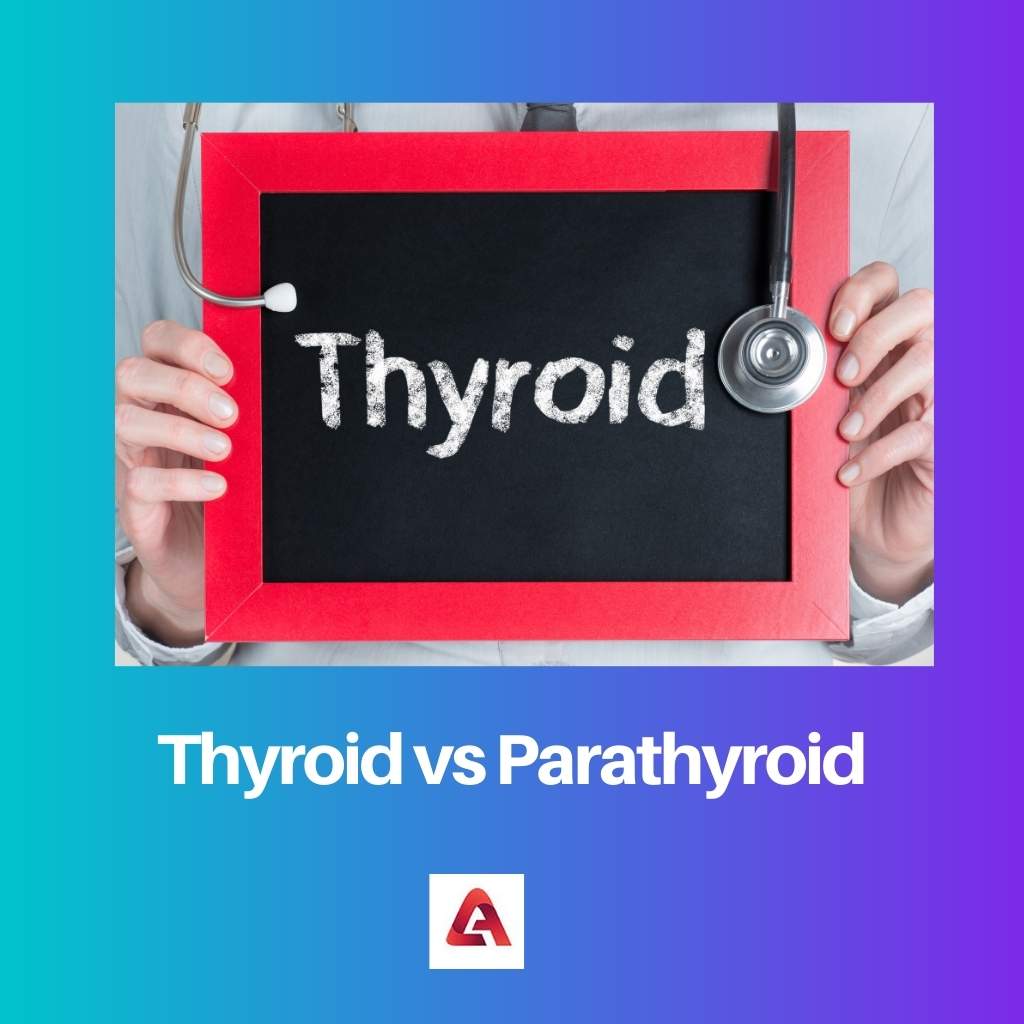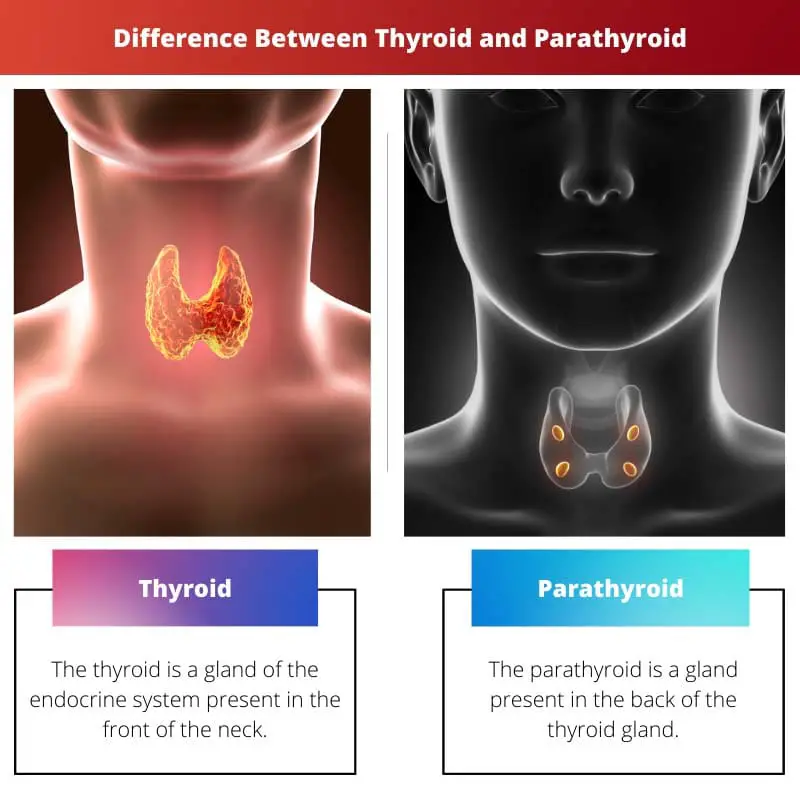The population is small compared to the diseases in the world. Around 10,000 diseases are rare and incurable. The diseases are categorised in many ways. They are infectious, deficiency, hereditary, genetic, non-genetic, and physiological.
Many diseases still have no medical treatment available for those diseases. The thyroid is the most common disease among women than men. It needs lifelong treatment.
Key Takeaways
- The thyroid gland produces hormones that regulate metabolism, while the parathyroid gland produces a hormone that regulates calcium levels.
- The thyroid gland is located in the neck, while the parathyroid gland is located behind the thyroid gland.
- Hypothyroidism and hyperthyroidism are common thyroid gland disorders, while hyperparathyroidism is a common disorder of the parathyroid gland.
Thyroid vs Parathyroid
The difference between thyroid and parathyroid is their position. The thyroid is a gland endocrine system that secretes thyroid hormone. The parathyroid is also a gland of the endocrine system that secretes parathyroid hormone. The thyroid and parathyroid are present in the neck region. The thyroid presents in front, and the parathyroid is present in the back of the thyroid glands. Only one large thyroid is present, but four parathyroid glands are present in the neck region.

The thyroid gland plays a vital role in thyroid disease. Thyroid disease is due to many reasons hormonal malfunctions, emotional reflections, genetic disorders, and psychological effects.
The production of thyroid hormone and its quantity in your body reflects thyroid disease. There are two types of thyroid diseases based on their secretion. They are hyperthyroidism and hypothyroidism.
The parathyroid is a gland present in the back of the neck or back of the thyroid gland. It is also a gland in the endocrine system. The parathyroid glands play the role of balancing the minerals and vitamins in the body.
The parathyroid gland secretes a parathyroid hormone that reflects the balancing process. The enormous secretion of the parathyroid hormone causes hyperparathyroidism in the body. The less secretion of parathyroid reflects hyperparathyroidism.
Comparison Table
| Parameters of Comparison | Thyroid | Parathyroid |
|---|---|---|
| Definition | The thyroid is a gland of the endocrine system present in the front of the neck. | The parathyroid is a gland present in the back of the thyroid gland. |
| Hormone secretion | Thyroid hormone | Parathyroid hormone |
| Numbers available | Only one thyroid gland | Four parathyroid glands |
| Lobes | Two lobes in butterfly structure | No lobes are in parathyroid |
| Regulation | Regulates metabolism in the body | Regulates the calcium and mineral levels in the body |
| Disorders | Hyperthyroidism and hypothyroidism | Hyperparathyroidism and hyperparathyroidism. |
What is Thyroid?
The endocrine system is one of the major systems in the human body. It contains the thyroid gland that secretes thyroid hormone, which has triiodothyronine and thyroxin.
The thyroid must be at the correct level. The change in levels reflects in the entire body. The thyroid is present below the voice box facing the front of the neck. It has two lobes and one large thyroid gland.
Isthmus is a tissue that connects the two lobes of the thyroid that looks like a butterfly. Colloid-filled follicles create the region of the thyroid. It is made of iodine molecules and surrounded by epithelial cells. Triiodothyronine and thyroxin are the units present in the thyroid hormone.
Three iodine molecules are present in triiodothyronine, and four iodine molecules are present in thyroxine. Goiter, thyroiditis, graves disease, thyroid cancer, and thyroid nodules are a few diseases caused by the thyroid gland.
Hypothalamus and pituitary gland are present in the brain playing the negative feedback mechanism. That controls the thyroid hormone secreted by the endocrine system. If blood plasma contains less thyroid hypothalamus, it induces the secretion of thyroxin secretion hormone.
At the same time, if the blood plasma contains more thyroid hormone, the hypothalamus sends the information to TSH to stop the secretion. Thyrodetectomy is to detect the extent of thyroid glands. MRI and CT scans also help to detect thyroid diseases.

What is Parathyroid?
The endocrine system secretes the parathyroid hormone. The parathyroid has four structures behind the one large thyroid gland. The parathyroid has parathyroid hormone. The oxyphil cells and chief cells are present in the round cells, which makes the parathyroid glands.
It produces a parathyroid hormone to balance the calcium and mineral level in the body. These can maintain the layer at the correct levels.
Calcitonin is called an antagonist of the parathyroid hormone.
The nervous system works only on calcium ions. The parathyroid hormone induces the osteoplast cells to break down the bone tissue. It also stops the settlement of osteoplast in the bone marrow.
The parathyroid hormone helps the intestine absorb more calcium ions to give calcium to the nervous system. The parathyroid has no lobes. The bone and kidneys are known as the target of the parathyroid hormone.
The variety in the calcium level of the bloodstream is found by the G-protein coupled cells in the parathyroid hormones. The negative feedback mechanism is played to trigger the PTH art right time and to stop at an unwanted time.
Hyperparathyroidism is due to more secretion of parathyroid hormone. Hypoparathyroidism is due to less secretion of parathyroid hormones. The parathyroid hormone regulates the phosphate level in the human body.

Main Differences Between Thyroid and Parathyroid
- The thyroid is an endocrine gland present below the voice box, and the parathyroid is an endocrine gland present at the back of the thyroid gland.
- Triiodothyronine is secreted by the thyroid, but the parathyroid hormone secretes parathyroid hormone.
- The thyroid has two lobes, but the parathyroid has no lobes.
- The thyroid is one large gland, and the parathyroid is four small glands.
- Hyperthyroidism and hypothyroidism are disorders of the thyroid. Hyperparathyroidism and hypoparathyroidism are disorders of the parathyroid.

- https://www.sciencedirect.com/science/article/pii/0887217195900330
- https://books.google.com/books?hl=en&lr=&id=sqLWDwAAQBAJ&oi=fnd&pg=PP1&dq=thyroid+vs+parathyroid&ots=eIZxYgPXG7&sig=jE_hhyNYSdLBpmywN8X7-4Ko05M

The detailed explanation of the thyroid gland’s structure, its hormone secretion, and the diseases it can cause offers a comprehensive understanding of thyroid function. The mention of diagnostic methods like thyroidectomy, MRI, and CT scans adds to the article’s value.
Absolutely, Qmorgan. The article’s detailed description of the thyroid’s structure and diagnostic methods provides valuable knowledge for readers.
Indeed, Qmorgan. The article’s emphasis on diagnostic methods enhances our understanding of how thyroid diseases can be detected and evaluated.
The explanation of how the thyroid hormone is regulated by the endocrine system and the impact of its secretion levels on the human body is quite intriguing. It’s also interesting to note the role of the hypothalamus and pituitary gland in controlling the thyroid hormone.
Absolutely, Tjones. The article’s explanation of the negative feedback mechanism and the detection of thyroid diseases adds depth to our understanding of thyroid function.
I completely agree, Tjones. The article provides valuable insights into the thyroid hormone regulation and its impact on the human body.
The article explains the disorders related to the thyroid and parathyroid glands in a clear and concise way. It’s fascinating to learn about the differences between hypothyroidism and hyperthyroidism, as well as the role of the parathyroid hormone in maintaining mineral levels in the body.
I agree, Oscar. The detailed comparison table provided in the article makes it easier to understand the contrasting features of the thyroid and parathyroid glands.
The detailed explanation of the thyroid and parathyroid glands, including their structures, functions, hormones, and disorders, provides a comprehensive overview of their significance in the human body. The mention of diagnostic methods and hormone regulation adds depth to the article’s content.
Absolutely, Harrison. The article’s thorough explanation of both glands and their respective functions offers valuable insights for readers.
Well said, Harrison. The article effectively captures the intricate details of the thyroid and parathyroid glands, providing a comprehensive understanding of their role in human physiology.
The article offers a comprehensive explanation of the parathyroid gland’s role in balancing calcium and mineral levels in the body. The description of the parathyroid hormone’s influence on osteoplast cells and calcium absorption is quite informative.
Well stated, Logan. The article’s focus on the parathyroid hormone provides a clear understanding of its impact on calcium balance and bone tissue regulation.
The detailed explanation of the structure and function of the parathyroid gland, along with the role of the parathyroid hormone, provides a comprehensive understanding of its significance in maintaining mineral levels in the body.
Well said, Eva. The article’s description of the parathyroid hormone’s influence on calcium and mineral balance is quite enlightening.
I couldn’t agree more, Eva. The article effectively highlights the importance of the parathyroid gland and its hormone in regulating mineral levels in the body.
The detailed comparison of the thyroid and parathyroid glands, along with the explanation of their respective disorders, offers a valuable understanding of their importance in human physiology. The role of the parathyroid hormone in regulating mineral levels is quite fascinating.
Absolutely, Carole. The article’s focus on the role of the parathyroid hormone in maintaining mineral levels provides informative insights for readers.
I couldn’t agree more, Carole. The article’s detailed descriptions add depth to our understanding of the thyroid and parathyroid glands.
The article provides an in-depth explanation of both the thyroid and parathyroid glands, offering valuable insights into their functions and the diseases related to them. The comparison table further enhances the understanding of these glands and their respective roles.
Well articulated, Mia. The article’s focus on the thyroid and parathyroid glands is indeed informative and enlightening.
I completely agree, Mia. The detailed explanations and comparison table contribute to a comprehensive understanding of the thyroid and parathyroid functions.
The article provides a detailed comparison of thyroid and parathyroid glands, explaining their roles and hormone secretion. It’s interesting to know that the thyroid gland plays a vital role in thyroid disease, and that the parathyroid gland is responsible for balancing the minerals and vitamins in the body.
You’re absolutely right, Sarah. The article offers a comprehensive understanding of both glands and how they impact the body’s overall health.
The article’s comparison of the thyroid and parathyroid glands provides valuable insights into their respective functions and significance in the human body.